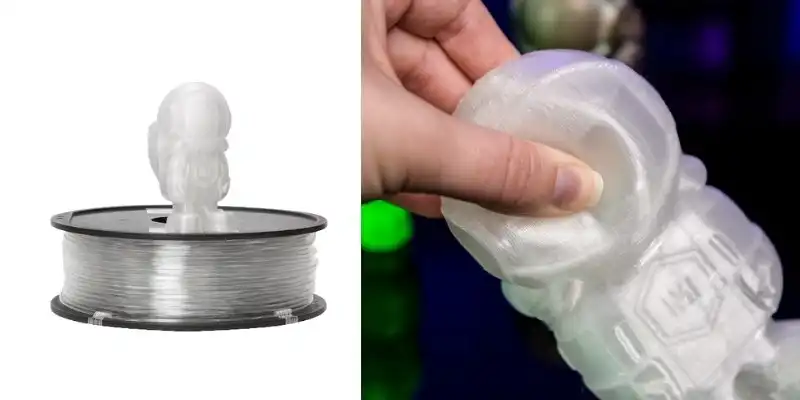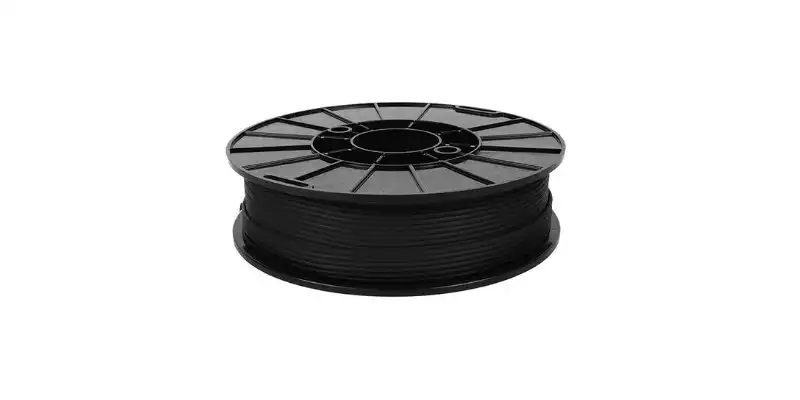The best flexible TPU filaments are durable and impact-resistant and offer an excellent surface finish that’s a pleasure to handle.
|
|
|
|
4.5
|
4.7
|
|
$29
|
$40-90
|
|
|
Flexible materials have a bad rap among makers for the perceived notion that they are trickier to print than PLA and ABS.
Why? It has higher temperature requirements, surging to 260°C for some brands, and its malleable properties. It’s never been easier to print bendy, quality parts, though, thanks to the rising popularity of 3D printing TPU.
In this guide, we’ll share our top recommendations for the best flexible filament brands around, help demystify the different types available, break down the core advantages and disadvantages, and provide some top tips for a smooth printing experience with flexible filaments.
Best TPU / Best Flexible Filament Brands
1. Ninjatek
- Price: Check price at Matterhackers here / Amazon here
- Printing Temperature: 210-250°C
- Shore Hardness: 75A, 83A, 85A, 90A, 95A
- Filament Diameter: 1.75 mm and 2.85 mm
- Available Colors: Black, white, gray, red, orange, yellow, green, blue, transparent
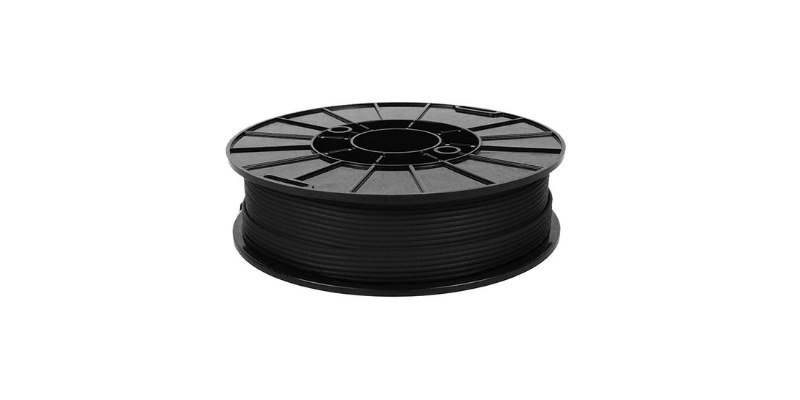
Pros
Premium quality.
Best flexible filament available.
Cons
Expensive.
NinjaTek’s TPU filament is synonymous with quality in 3D printing circles and the material of choice for discerning makers. It’s premium stuff with an expensive price tag in tow, but worth every penny as it is undoubtedly some the best flexible filament available.
NinjaTek offers a range of TPU blends covering most Shore Hardness ratings from ultra-soft Chinchilla 75A to tough Cheetah 95A.
2. Polymaker PolyFlex TPU
- Price: Check price at Matterhackers here / Amazon here
- Printing Temperature: 200-230°C
- Shore Hardness: 90A, 95A
- Filament Diameter: 1.75 mm and 2.85 mm
- Available Colors: Black, white, gray, teal, orange, red, blue, yellow
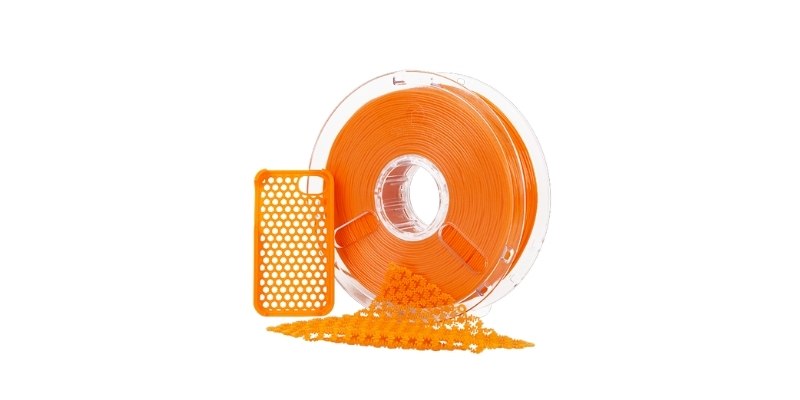
Pros
Shine for demanding applications.
A fine balance between durability and elasticity.
Cons
Not as much of a glossy finish as other brands.
PolyMaker’s PolyFlex family regroups some of the best TPU blends available commercially. They shine for demanding applications that require a fine balance between durability and elasticity with solid UV resistance woven in, too. They are also affordably priced and cover 95A and 90A Shore Hardness, both great at making the TPU printing experience a little easier to handle.
3. Recreus Filaflex
- Price: Check price here
- Printing Temperature: 215-235°C
- Shore Hardness: 60A, 70A, 82A, 95A, 96A
- Filament Diameter: 1.75 mm and 2.85 mm
- Available Colors: Black, white, gray, peach, red, orange, blue, green, yellow, orange, pink, brown
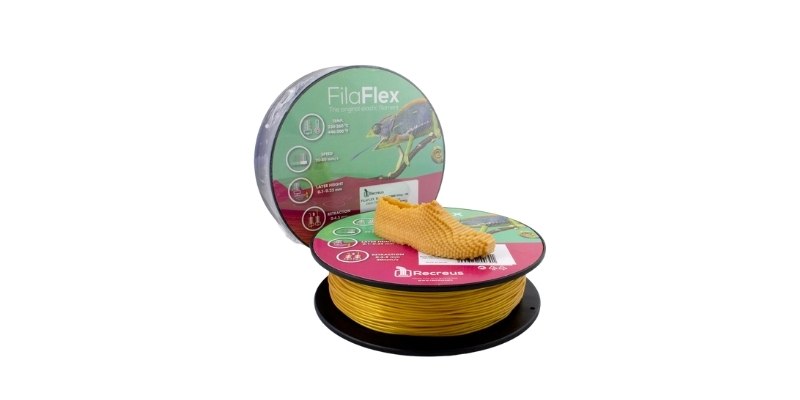
Pros
Quality product.
Ordoless and acetone, solvent, and fuel resistant.
Cons
Can be tricky to use at first.
Recreus’ Filaflex is one of the oldest and best TPU filaments on the market, and with years of fine-tuning the formula, you’re certainly buying a quality product.
The straight Filaflex options cover 60A, 70A, 82A, and 95A, while Recreus also has specialist blends, including Conductive Filaflex and Filaflex Purifier, a TPU designed to absorb CO2. All Filaflex is odorless and acetone, solvent, and fuel resistant.
4. Matterhackers TPU – Build Series & PRO Series
- Price: Build Series around $29 here / PRO series around $50 here
- Printing Temperature: 230-240°C
- Shore Hardness: 95A
- Filament Diameter: 1.75 mm and 2.85 mm
- Available Colors: Black, gray, white, transparent, red, green, blue, orange, purple
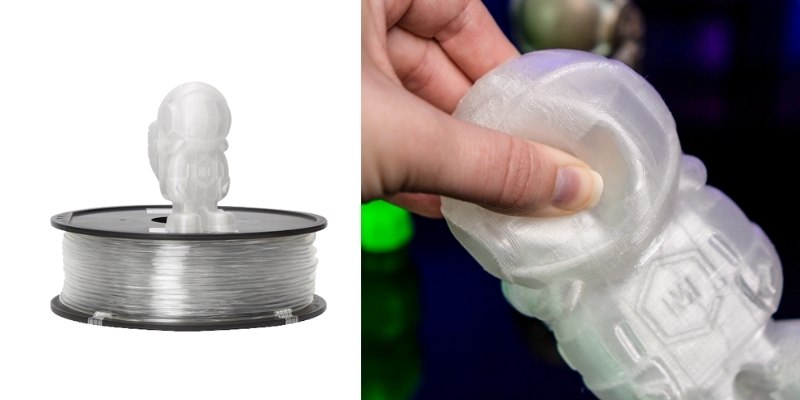
Pros
Two options to choose from.
Range of colors available.
Cons
No major drawbacks.
Matterhackers TPU offering is two pronged. On one side, you have the low-cost MH Build Series TPU, geared to produce quality printed parts without breaking the bank.
On the other, the PRO Series TPU is a premium blend boasting that coveted mix between elasticity and strength. This being MatterHackers, you’ll find an expansive range of available colors, but Shore Hardness is stuck on standard 95A.
5. Dynamism TPU HS
- Price: $50 – Available at Dynamism here
- Printing Temperature: 200-220°C
- Shore Hardness: 95A
- Filament Diameter: 1.75 mm and 2.85 mm
- Available Colors: Black
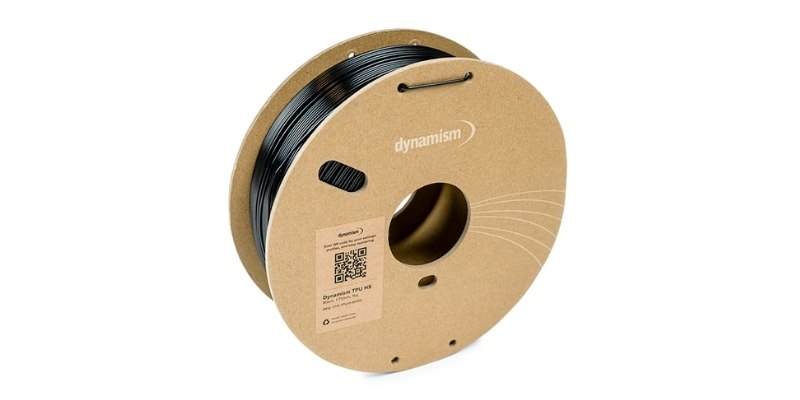
Pros
Reliable workhorse.
Produces quality prints for an affordable price point.
Cons
Not many color choices are available.
If you need a reliable, workhorse TPU capable of producing quality prints that weighs in at just about affordable, Dynamism TPU HS is a winner.
It’s tuned for high flow printing; you can crank up the print speed compared to other best TPU brands. Slim pickings on color and Shore Hardness, black and 95A, respectively.
6. Sunlu TPU – best cheap TPU filament
- Price: Check price at Amazon here
- Printing Temperature: 200-230°C
- Shore Hardness: 95A
- Filament Diameter: 1.75 mm and 2.85 mm
- Available Colors: Black, white red, blue, green, orange, yellow
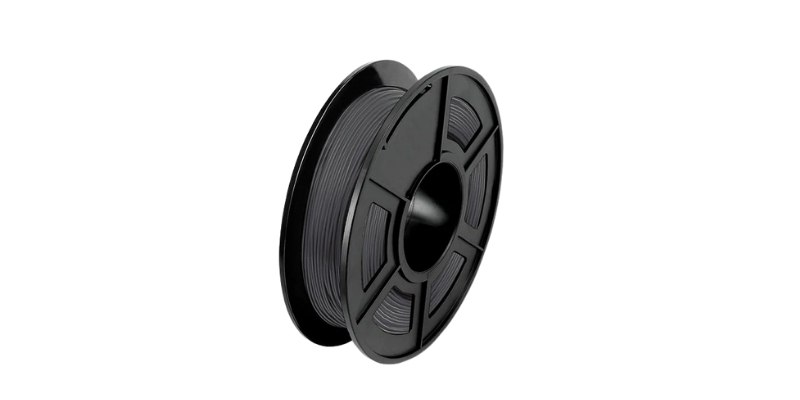
Pros
Cheap and cheerful.
Solid general-purpose TPU.
A steal for the price.
Cons
Not the best print results.
Cheap and cheerful, but without sacrificing too much in the way of quality, Sunlu TPU is a solid general-purpose TPU for makers who want to try their hand at TPU but aren’t too fussed about the very best print results.
At $20 a spool, it’s a genuine steal. Add a nice selection of colors and an eco-friendly formula, and Sunlu offers an excellent starter TPU.
How to 3D Print Flexible Filament (TPU/TPE) – Tips
- Print slowly: 20-40mm/s is a good starting point for most flexible. Direct drive extruders also work better, as Bowden tubes can cause extra friction.
- Check your temperature: TPU and flexible filaments print at anywhere between 210-260°C, depending on the blend. If filament oozes and over extrudes, turn the temperature down; if it’s under extruding, turn the temperature up.
- Retraction settings: flexible can leak more than standard filaments between extruding points. Check your slicer settings to optimize for this.
- Use the right bed surface: a thin coating of glue stick gives great results. Some surfaces like PEI can stick too well, so be wary of that.
Tips For Printing The Best Flexible Filament
What Cura Settings to Print TPU Filament With?
The right settings will largely depend on your printer and the TPU brand. As a general guide, we recommend the following:
- Nozzle Temperature – 220°C to 260°C
- Bed Temperature – 0°C to 60°C, depending on manufacturer recommendations
- Print Speed – 5-30 mm/s
- Retraction – 3 mm at 20 mm/s, but don’t hesitate to lower it based on results
- Cooling Fan – Initially set to 0%, then shift to higher as the print progresses, but no higher than 50%
Retraction
If you’re running a new printer, you can tune your retraction settings in line with those of PLA and ABS. For older printers, low retraction settings are vital. The path through the extruder is perfectly designed for flexible filament to clog, wind, and jam around the gears, something exacerbated by high retraction settings. In this case, you’ll want to run very low retraction or turn it off entirely for the best results.
Direct Drive Extruder
Though flexibles work well enough with Bowden systems, they have an easier time with direct-drive extruders. These minimize the potential for the filament to bend, snap, stretch, or otherwise ruin your prints, thanks to a shorter gap between the extruder and hot end. If possible, use a direct drive printer.
Print Slow and Hot
Flexibles thrive when print speeds are tuned low. Don’t hesitate to drop down anywhere from 5 mm/s to 30 mm/s for the best results. Similarly, these materials prefer very hot nozzle temperatures. Look to manufacturer recommendations for the latter.
Keep Flexible Filament Dry
An obvious one, but do your very best to ensure flexible filament is kept dry and away from moisture. Proper storage is critical.
Different Types of Flexible Filament
TPE – ThermoPlastic Elastomer is an umbrella term for a cross-section of flexibles, including TPU, that regroups the properties of rubber into a plastic polymer.
TPU – ThermoPlastic Polyurethane is the most commonly used flexible for 3D printing. It’s more rigid than straight TPE, which eases the printing processes, hence why makers favor it. TPU also has superb resistance properties, covering chemicals, abrasion, temperature, vibration, and impact.
TPC – Thermoplastic Co-Polyester is an industrial-grade flexible, generally used in fields such as medicine. It’s not as elastic as TPU, but it’s considerably tougher and stronger, along with boosted resistance to chemicals and high temperatures. TPC is usually printed with powder bed fusion printers.
PLA Blends – PLA+ and Soft PLA are PLA filaments designed to reduce the natural brittleness of standard PLA to increase their durability and impact resistance. They are also formulated to offer better elasticity. Soft PLA blends PLA with TPU for a best of both worlds material.
For more in-depth details about each of these different types of flexible filament, be sure to check out our complete flexible filaments 3D printing guide.
How To Pick The Best TPU
Shore Hardness
Flexibles come in different levels of hardness, measured in Shore Hardness, a measurement of a material’s hardness. You’ll find options running from highly flexible to reasonably stiff.
For 3D printer flexibles, the Shore Hardness ranges from around 75A to 100A, with the numerical value ascending in hardness. With 100A being much less flexible (think the rubber on a shopping cart wheel) – and 75A being more or less the softest limit you can print using current FDM printers. Stiffer materials tend to be easier to print, while very soft materials can be problematic.
We recommend sticking to no lower than 85A as incredibly soft filament tends to complicate the printing process.
- Interested in seeing filament strength in action? Check out our guide to how strong are 3D printed parts.
Buy From Reputable Brands
Flexibles are difficult enough to print without throwing in a sketchy third-party manufacturer who’s out to cash in on unsuspecting makers rather than provide a solid product.
To avoid mishaps and potentially hours of wasted time, stick to the well-known, best flexible filament brands – MatterHackers, PolyMaker, NinjaTek, Colorfabb, Sainsmart, etc.
Advantages and Disadvantages of Flexible Filament
Advantages
- Flexible and durable: flexibles resemble rubber in their elasticity, often bending and extending well beyond their normal shape without breaking.
- Resistant: flexible filament is generally impact, abrasion, UV, low-temperatures, chemical, oils, greases, and solvent resistant.
- Smooth finish: Printed flexible generally boasts a smooth surface finish, ideal for soft consumer parts subject to regular handling.
- Warp-free: unlike other 3D printed filaments like ABS, flexible rarely curl, offering superb layer adhesion.
Disadvantages
- Stringing: flexibles are particularly susceptible to stringing during the printing process.
- Tricky to print compared to PLA: the natural elastic properties of flexibles can make the printing process challenging, with clogging and jamming a common issue for printers that aren’t set up, dialed, and calibrated correctly to handle flexible filament.
- Hygroscopic: flexibles absorb moisture, which can affect printing performance.
- Post-Processing: due to its composition and elasticity, flexible filament isn’t suited to heavy post-processing work.
FAQs
How to Dry TPU Filament?
For convenience, the best way to dry TPU is to invest in a dedicated filament drying system such as the Sunlu FilaDryer S1 and PrintDry Pro. These devices automate the drying process for you.
Beyond these, there are multiple DIY options. Using a standard domestic oven or food dehydrator is a popular choice, or you can experiment with more left-field solutions, such as a lamp placed in a bucket perforated with air holes.
What is TPU filament used for?
TPU is used for a broad range of applications requiring strong, durable, impact-resistant, and flexible parts, such as phone cases, shoe soles, straps, bumpers, RC car tires, etc.
How to Store TPU Filament?
TPU is best stored in an airtight container or resealable vacuum bag with desiccant sacs. If TPU does absorb moisture, it’s possible to dry it out using several methods, including an oven, purpose filament dryer, or food dehydrator. Although not as hygroscopic as nylon, TPU still readily absorbs moisture if left out in the open.
How to Dry TPU Filament in an Oven?
Set your oven to 55°C/131°F, place the TPU spool inside, and leave it to dry for around four hours to remove all the accumulated moisture.
How to Improve Supports When Printing TPU Filament?
If you’re set on using supports, the first step is to extend the distance between the print and supports. Next, reduce the support infill density. However, we recommend a dual extruder printer that can print the supports in soluble PVA for the best results.
TPU and supports don’t play nice together because the best TPU boasts incredibly strong layer bonding properties, which means removing supports is a task and a half that often ruins the part’s surface finish.
How Much Does TPU Filament Cost?
A 1 kg spool of TPU filament costs roughly $30 to $50 for entry-level options, but for more premium, high-quality TPU blends, the cost can rise to $100+.
How Susceptible Is TPU Filament to Moisture?
Even the best TPU filament is relatively hygroscopic, which signals that it pulls moisture from the ambient air if left exposed. Prevention is the best way to counteract this. Store your TPU in an airtight container when not in use.
What 3D Printer Filament Is Flexible?
TPU, TPE, PCTPE, Soft PLA, TPC, and PLA+ are all considered flexible filaments. But, even standard 3D printer filaments like Nylon are somewhat flexible, which aids their impact resistance.
How to Print Flexible Filament on Ender 3?
Yes, you can 3D print TPU and flexibles on the Ender 3 – you can read our full guide here, and learn more about the best filaments for Ender 3.
Is TPU filament like rubber?
Of all the available 3D printing filaments, TPU is the one that mimics the properties of rubber the most. It’s flexible, durable, and tough, just like rubber.
What is better, PLA or TPU?
It depends on your needs. The best TPU is flexible but tough to print, while PLA is stiff and brittle but easy to print.
Is TPU Filament Toxic?
Like all 3D printer filament, the TPU printing process does release fumes and particles that can be damaging if inhaled in large doses, so adequate ventilation is required. Printed TPU is no more toxic than PLA and ABS.
Are TPU and PETG the Same?
No, Polyethylene Terephthalate Glycol and Thermoplastic Polyurethane are different types of filament. PETG is best considered as a more flexible form of PLA, while TPU is vastly more elastic and impact resistant.

